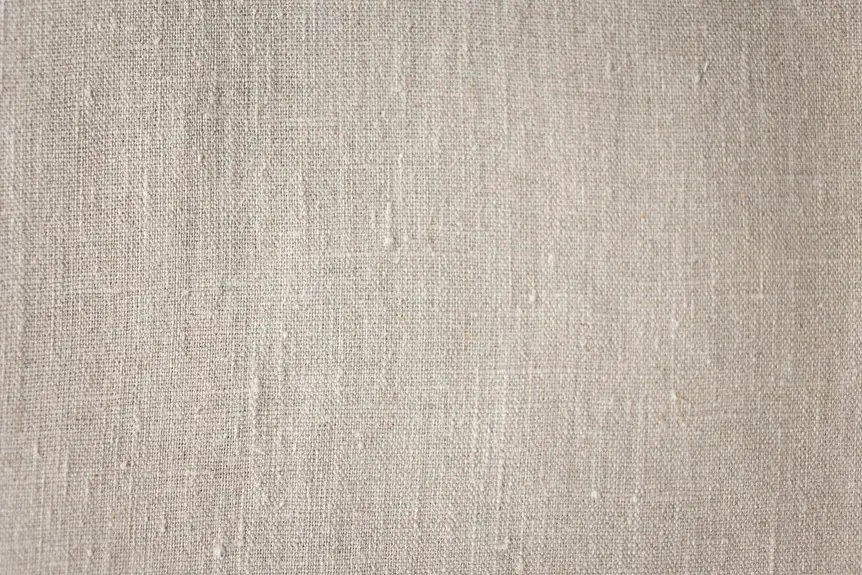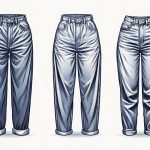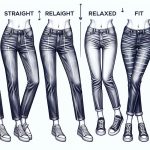Imagine wearing a pair of jeans that could outlast your favorite chair—hemp fabrics can do just that. With their thicker fibers and impressive tensile strength, hemp garments often last over a decade, while cotton tends to wear out much sooner. But what makes hemp so resilient? Let’s explore the factors that contribute to its durability and see how it stacks up against traditional fabrics.
Table of Contents
Key Takeaways
- Hemp fibers are thicker and possess higher tensile strength, making them more durable than cotton.
- Hemp fabrics resist wear and tear better, maintaining their integrity during intense activities.
- They are naturally resistant to mold and mildew, enhancing their longevity compared to cotton.
- Hemp fabrics can last over 10 years, significantly outlasting cotton’s typical lifespan of 3-5 years.
- Their strong fibers prevent fraying and breakdown, ensuring a longer-lasting appearance and feel.
Comparing the Strength of Hemp and Cotton
When you compare the strength of hemp and cotton, you’ll quickly notice that hemp often outperforms cotton in durability.
Hemp fibers are naturally thicker and have a higher tensile strength, allowing them to withstand wear and tear much better. This means that your hemp garments can handle intense activities without fraying or losing their shape.
Hemp fibers’ thickness and tensile strength ensure garments endure intense activities without fraying or losing shape.
Cotton, while soft and comfortable, tends to break down faster under stress, leading to rips and tears over time.
Additionally, hemp’s resistance to mold and mildew makes it ideal for various environments, further enhancing its durability.
When you choose hemp, you’re opting for a fabric that not only lasts longer but also maintains its integrity, making it a smart choice for sustainable fashion.
Longevity: How Long Do Hemp Fabrics Last?
Although many factors influence the longevity of fabrics, hemp stands out for its remarkable durability. When you choose hemp, you’re investing in a fabric that can last years, often outlasting cotton and synthetic alternatives. Proper care, like washing in cold water and avoiding harsh chemicals, can extend its life even further.
Here’s a quick comparison of hemp fabric longevity against other materials:
| Fabric Type | Average Lifespan |
|---|---|
| Hemp | 10+ years |
| Cotton | 3-5 years |
| Polyester | 5-7 years |
Choosing hemp means you enjoy not only eco-friendliness but also a long-lasting fabric that stands the test of time. So, if longevity is essential to you, hemp’s a solid choice!
Resistance to Wear and Tear
When you choose hemp fabrics, you’re opting for material with impressive natural resilience.
Its ability to resist pilling and abrasion means your items will maintain their look and feel over time.
Let’s explore how these factors contribute to the long-lasting durability of hemp.
Hemp’s Natural Resilience
Hemp’s natural resilience makes it a standout choice for fabrics that endure daily wear and tear. When you choose hemp, you’re opting for a material that can withstand the rigors of everyday life.
It’s not just strong; it also has a unique ability to flex and adapt without losing its shape or integrity. This means your hemp garments are less likely to succumb to stress or damage over time.
Whether you’re wearing it on a hiking trip or during a casual outing, hemp maintains its durability, ensuring longevity and comfort. Plus, its breathable nature helps regulate temperature, adding to its practicality.
Pilling and Abrasion Resistance
While many fabrics can show signs of wear over time, hemp stands out for its impressive pilling and abrasion resistance. This means your hemp clothing or textiles can withstand daily use without easily developing those annoying little balls of fuzz or losing their integrity.
Here’s a quick comparison:
| Feature | Hemp Fabric |
|---|---|
| Pilling Resistance | High |
| Abrasion Resistance | Excellent |
| Typical Lifespan | Longer than cotton |
Thanks to its strong fibers, hemp doesn’t just look good; it performs well too. So, if you want something that can handle the rigors of everyday life without falling apart, hemp is a fantastic choice!
Long-lasting Durability Factors
The impressive pilling and abrasion resistance of hemp fabrics is just the beginning of their durability. When you choose hemp, you’re opting for a material that stands the test of time.
Its natural fibers resist wear and tear better than many alternatives, making it ideal for everyday use. You’ll notice that hemp is less likely to fray or break down, even after repeated washing. This resilience means your clothing and home textiles will maintain their shape and integrity longer.
Additionally, hemp’s breathability and moisture-wicking properties help prevent mold and mildew, which can weaken fibers over time. By investing in hemp fabrics, you’re not just getting style—you’re ensuring your pieces last, saving you money and reducing waste in the long run.
The Role of Fiber Length in Durability
When considering the durability of hemp fabrics, fiber length plays an essential role that can’t be overlooked. Longer fibers often contribute to stronger, more resilient fabrics. They create a more unified structure, reducing the likelihood of fraying or tearing. Conversely, shorter fibers can lead to weaker areas in the material, making it less durable.
Here’s a quick comparison of fiber lengths:
| Fiber Length | Durability | Common Uses |
|---|---|---|
| Short | Low | Low-quality textiles |
| Medium | Medium | Standard garments |
| Long | High | High-performance wear |
Choosing the right fiber length is vital for ensuring the durability of your hemp fabric products. This can make a significant difference in how well they stand up to wear and tear.
Advances in Hemp Processing
As innovations in hemp processing continue to evolve, you’re likely to see significant improvements in the quality and durability of hemp fabrics.
Advanced techniques like enzymatic processing and bio-refining are enhancing fiber extraction, making it easier to produce longer, stronger strands. These methods reduce impurities, resulting in a purer and more resilient fabric.
You may also notice more efficient spinning technologies that create tighter, more cohesive yarns, increasing durability. In addition, improved dyeing processes guarantee that colors last longer without compromising the fabric’s integrity.
As producers adopt these cutting-edge techniques, hemp fabrics won’t only become more durable but also more appealing to consumers seeking sustainable options.
This evolution showcases hemp’s potential as a leading material in the textile industry.
Environmental Benefits of Hemp Fabrics
Hemp fabrics not only offer durability but also present significant environmental benefits that make them an attractive choice for eco-conscious consumers. Hemp grows quickly and requires less water compared to traditional crops, helping to conserve precious resources. Additionally, it naturally enriches the soil, reducing the need for synthetic fertilizers.
Here’s a quick comparison of environmental impacts:
| Benefit | Hemp Fabrics |
|---|---|
| Water Usage | Low |
| Soil Health | Improves |
| Pesticide Need | Minimal |
| CO2 Absorption | High |
Choosing hemp fabrics means you’re supporting sustainable practices that lower your carbon footprint while promoting a healthier planet. Embracing hemp helps create a more eco-friendly future for everyone.
Economic Factors Impacting Hemp Production
The growing popularity of hemp fabrics not only highlights their environmental benefits but also underscores the economic factors influencing hemp production.
For one, market demand plays a significant role; as consumer awareness rises, so does the need for sustainable fabrics. This increase can lead to higher prices for hemp, benefiting farmers and manufacturers alike.
Additionally, government policies and subsidies can either support or hinder hemp cultivation. When incentives are in place, it encourages more farmers to grow hemp, thereby boosting production.
Government policies and subsidies play a crucial role in promoting or restricting hemp cultivation, directly impacting production levels.
On the flip side, regulatory challenges might limit growth potential. Ultimately, you’ll find that these economic dynamics are vital in shaping the future of hemp fabric production, impacting availability, pricing, and overall market viability.
Comfort and Texture: Hemp vs. Cotton
When it comes to comfort and texture, hemp and cotton each offer unique benefits.
You’ll find that hemp boasts impressive breathability and moisture-wicking properties, making it a great choice for active wear.
Over time, hemp fabrics can even soften, providing a cozy feel that rivals cotton’s familiar touch.
Breathability Comparison
While both hemp and cotton are popular choices for breathable fabrics, their comfort and texture can vary considerably.
Hemp tends to be more breathable than cotton, allowing air to circulate better, especially in warmer conditions. You’ll notice that hemp fabric feels cool against your skin, making it ideal for hot weather.
Cotton, while generally breathable, can retain moisture, which may lead to a heavier feeling when you’re sweating.
When it comes to texture, hemp fabrics can feel more textured and rugged, while cotton usually provides a softer, smoother touch.
If you’re looking for breathability, hemp’s superior airflow might make it the better option.
Ultimately, your choice will depend on your personal preference for comfort and the specific use you have in mind.
Softness Over Time
Although hemp fabrics start with a coarser texture compared to cotton, they soften remarkably with each wash, making them increasingly comfortable over time. You’ll find that after a few washes, hemp’s initial stiffness transforms into a gentle, luxurious feel against your skin.
| Wash Cycle | Hemp Fabric Softness | Cotton Fabric Softness |
|---|---|---|
| 1 | Coarse | Soft |
| 2 | Slightly Softer | Softer |
| 3 | Noticeably Soft | Soft |
| 4 | Very Soft | Softer |
| 5 | Luxuriously Soft | Soft |
This transformation not only enhances your comfort but also creates a unique, lived-in feel that cotton just can’t replicate. Embrace the journey of softness with hemp!
Moisture Wicking Efficiency
Hemp fabrics not only soften beautifully over time but also excel in moisture-wicking efficiency, setting them apart from cotton.
When you wear hemp, you’ll notice it draws moisture away from your skin, keeping you dry and comfortable, especially in hot or humid conditions. Cotton, while soft, tends to absorb moisture, which can leave you feeling damp and uncomfortable. This difference is essential if you’re active or sweat easily.
The breathability of hemp enhances its moisture-wicking properties, allowing for better airflow. You’ll appreciate how hemp’s texture feels cool against your skin, making it a great choice for everyday wear.
Ultimately, if comfort in varying climates is a priority for you, hemp fabrics are an excellent option to take into account.
Practical Applications of Hemp Fabrics
As you explore the world of textiles, you’ll find that hemp fabrics offer a diverse range of practical applications that cater to both functionality and sustainability.
You can use hemp for clothing, where its breathability and durability make it ideal for everyday wear. It’s also great for accessories like bags and belts, providing a strong yet stylish option.
If you’re into home decor, hemp fabrics can be transformed into curtains, upholstery, or rugs, adding a unique touch to your space.
Additionally, hemp’s natural resistance to mold and UV rays makes it suitable for outdoor gear.
Hemp’s inherent resistance to mold and UV rays makes it an excellent choice for durable outdoor gear.
In various industries, from fashion to home goods, you’ll discover that hemp fabrics are versatile and eco-friendly, meeting your practical needs while supporting sustainable practices.
The Future of Hemp in the Textile Industry
With its numerous practical applications in clothing, accessories, and home decor, the potential for hemp in the textile industry continues to expand.
You’ll find that as sustainability becomes a priority for consumers, hemp’s eco-friendly nature positions it as a frontrunner. Innovations in processing techniques are enhancing its softness and versatility, making it even more appealing.
You might see hemp blended with other fibers, creating durable fabrics that meet diverse style preferences. As brands embrace transparency, you can expect more information on sourcing and production methods, fostering trust.
The future looks bright for hemp textiles, paving the way for increased market presence.
As you explore your options, consider how incorporating hemp can align with your values and contribute to a sustainable future.
Frequently Asked Questions
Can Hemp Fabrics Be Recycled or Composted?
Yes, you can recycle or compost hemp fabrics. They break down naturally, making them an eco-friendly option. Just verify any dyes or treatments used are also biodegradable to fully enjoy their environmental benefits.
How Does Hemp Fabric Compare to Synthetic Materials?
Imagine a superhero fabric, combining strength and sustainability. When you compare hemp to synthetic materials, you’ll find hemp’s natural resilience and breathability outshine the harshness of synthetics, offering you a healthier, eco-friendly alternative for everyday use.
Are There Any Allergies Associated With Hemp Fabrics?
You won’t typically find allergies linked to hemp fabrics, as they’re hypoallergenic. Most people tolerate them well, but if you have a sensitivity to plants, it’s wise to test a small area before full use.
What Maintenance Is Required for Hemp Fabrics?
To maintain hemp fabrics, you should wash them in cold water and avoid bleach. Air drying is best, as high heat can damage the fibers. Regularly check for stains and treat them promptly to keep them looking fresh.
Can Hemp Fabric Be Dyed Easily?
Did you know hemp can absorb up to 30% of its weight in dye? You’ll find that hemp fabric takes dye well, allowing you to achieve vibrant colors and unique patterns with ease in your projects.
- Does Chiffon Fabric Stink - July 15, 2025
- Does Chiffon Fabric Affect the Economy - July 15, 2025
- Does Cotton Fabric Have a Nap - July 15, 2025







